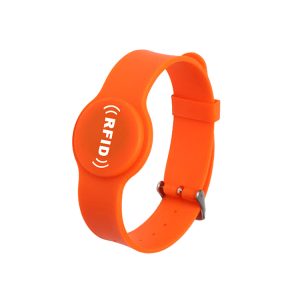RFID key fob is a smart device that uses radio frequency identification (RFID) technology, which combines modern technology with the form of a traditional keychain. RFID keychains are typically constructed from chips and coils encased in an ABS plastic shell, which is then filled with epoxy resin and ultrasonically welded into a variety of designs. This keychain can encapsulate chips that are high-frequency (like 13.56MHz) or low-frequency (like 125KHz), and it can even compositely encapsulate two chips. RFID key fob ease, robustness, safety, adaptability, and customizability are making them more and more significant in today’s world.

How a key fob works
The working principle of the key fob is based on short-range radio technology and radio frequency identification (RFID) technology. It integrates an RFID chip and an antenna inside, which sends a specific coded signal to a compatible receiver via radio frequency.
When the key fob is close to the receiver, the transmitter of the receiver sends a signal to the key fob, stimulating its built-in RFID chip. Subsequently, the key fob adjusts its frequency to match the signal of the transmitter and is ready for communication. The communication process will start immediately as soon as the user presses a button on the key fob.
The main task of the RFID chip is to transmit specific RFID tag information. This information must match the information programmed in the receiver device. Taking a car as an example, a specifically programmed key fob can only unlock or lock that vehicle because other key fobs cannot match the receiver information of the vehicle.
In addition, RFID key fobs can be flexibly programmed to perform various commands. In automotive applications, different buttons are usually assigned different functions, such as remotely locking and unlocking the vehicle, starting the ignition, activating or disarming the security system, popping up the trunk lock, and controlling automatic windows.
The precision and security of this technology make RFID key fobs an indispensable part of modern life, providing users with a convenient and safe experience.
Key fobs and multifactor authentication
Key fobs and multifactor authentication (MFA) are key components in modern security systems. Together, they improve the security of corporate networks, devices, applications, and data. Here is a detailed explanation of key fobs and multifactor authentication:
Multifactor authentication (MFA)
Definition:
Multifactor authentication (MFA) is a security authentication method that requires users to provide two or more verification factors to confirm their identity. These factors usually include the following categories:
Possession: A physical device or item that the user has, such as a key fob, smartphone, etc.
Inherent: A biometric feature unique to the user, such as a fingerprint, facial recognition, etc.
Knowledge: Information that the user knows, such as a password, PIN, etc.
Benefits:
Using MFA can significantly improve the security of the system because even if one verification factor is stolen or cracked, the attacker still needs to obtain other factors to successfully intrude. This greatly increases the difficulty and cost of the attack.
Application of key fobs in MFA
Function:
In an MFA system, key fobs are usually used as the “possession” verification factor. The user first performs preliminary authentication through other verification factors (such as passwords or biometrics), and then uses the key card to generate a pseudo-random token code (also known as a one-time password OTP) to complete the final authentication process.
Process:
The user first logs in to the system through a traditional username and password or other biometrics.
The system sends a request to the key card to generate a one-time password.
After receiving the request, the key card generates a pseudo-random one-time password and displays it on the screen or notifies the user through other means (such as sound, vibration, etc.).
The user enters the one-time password into the system within the specified time.
The system verifies the validity of the one-time password, and if the verification is passed, the user gains access.
Security:
One-time passwords usually have a short validity period (such as 30 to 60 seconds), and if the user fails to use it within the validity period, the password will automatically expire. This further improves the security of the system because even if the one-time password is stolen, the attacker has only a short time window to use it.
The combined use of key cards and multi-factor authentication provides enterprises with a powerful and flexible security solution. By requiring users to provide multiple verification factors, enterprises can ensure that only legitimate users can access their sensitive assets, thereby effectively preventing data leaks and other security threats.

What is the Function of an RFID Key Fob and How Does it Differ from a 125khz RFID Key Fob?
An rfid key fob technology is designed to provide secure access to buildings or vehicles. It uses radio frequency identification to transmit a unique code to a reader, allowing authorized individuals to gain entry. The 125khz RFID key fob operates at a lower frequency than other RFID key fobs, offering a different level of security.
Combination of key fobs and biometric authentication
Biometric authentication, as an important way of modern security authentication, verifies identity based on the user’s unique biometric features (such as fingerprints, iris scans, and voiceprints). Compared with traditional password authentication, biometric authentication has higher security and convenience because biometric features are unique to each person and difficult to copy or imitate.
The role of key fobs in biometric authentication:
- Integrate biometric technology: Some advanced key fobs have integrated biometric authentication technology, such as fingerprint recognition. Users can not only authenticate physically through the key fob but also through its built-in biometric recognition module.
- Enhanced security: By integrating biometric authentication into the key fob, users can get additional security protection. Even if the key fob is lost or stolen, unauthorized users cannot access protected resources by simple copying or imitation.
- Verification process: When users need to use the key fob for authentication, they need to follow the device’s requirements. For fingerprint recognition, users may need to place their fingers on the fingerprint recognition area of the key fob to let the device read the fingerprint ridges and seven layers of skin information of the fingertips. The device then compares the information it reads with a pre-stored template to verify the user’s identity.
- Convenience: Although biometric authentication adds security, it does not sacrifice convenience. Instead of having to remember complex passwords or carry additional authentication devices, users can simply use the key fob they carry with them to complete authentication.
The combination of key fob and biometric authentication provides users with an additional level of security protection. By integrating biometric authentication technology, the key fob becomes not only a simple physical authentication tool but also a powerful digital authentication solution. This combination allows users to enjoy higher security while maintaining convenience.

What are the benefits of key fobs?
The benefits of key fobs are mainly reflected in the security and convenience they provide. The following are the specific benefits:
Enhanced security:
As a physical authentication device, key fobs make it more difficult for attackers to gain access. Attackers not only need to obtain the user’s password but also need to physically possess the key fob to access the system or network.
Key fobs can generate one-time random passwords that expire after a fixed time, effectively preventing passwords from being reused or abused after being intercepted.
Key fobs support multi-factor authentication (MFA), which further enhances the security of the system by combining other verification factors (such as passwords, biometrics, etc.).
Higher convenience:
Users do not need to remember complex passwords or carry additional authentication devices. They only need to carry daily key fobs to complete authentication, which greatly simplifies the login process.
Key fobs usually have a simple and intuitive user interface, which reduces the user’s learning cost and difficulty of operation.
Flexible management:
Administrators can remotely program and manage multiple key fobs through back-end software to achieve flexible control of user access rights.
Multiple access levels can be created to grant or deny access to networks, facilities, or equipment according to the needs and permissions of different users.
Through communication with RFID readers, the use of key cards can be monitored and managed in real-time, and potential security risks can be discovered and handled in a timely manner.
Wide applicability:
Key cards are suitable for various commercial facilities, including factories, offices, restricted areas (such as server rooms), laboratories hospitals, etc., and can meet security needs in different scenarios.
Key cards can be integrated with other security systems (such as video surveillance systems, alarm systems, etc.) to achieve more comprehensive security protection.
High reliability:
Key cards usually have a long service life and stable performance and can work reliably in various environments.
Key cards use advanced encryption technology to ensure the security of data transmission and storage.
![Rfid Tag manufacturer [Wholesale | OEM | ODM]](https://www.fjrfidfactory.com/wp-content/uploads/2024/04/logo.webp)






